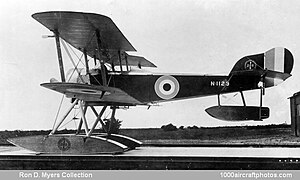| Baby | |
|---|---|
 Sopwith Baby in use with the Royal Norwegian Navy Air Service | |
| General information | |
| Type | scout and bomber floatplane |
| National origin | United Kingdom |
| Manufacturer | Sopwith Aviation Company |
| Status | Retired |
| Primary users | Royal Naval Air Service |
| Number built | 386 [note 1] |
| History | |
| Introduction date | 1915 |
| First flight | September 1915 [1] |
| Developed from | Sopwith Schneider |
| Variants | Fairey Hamble Baby |
The Sopwith Baby is a British single-seat floatplane that was operated by the Royal Naval Air Service (RNAS) from 1915.

